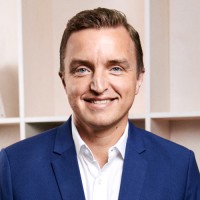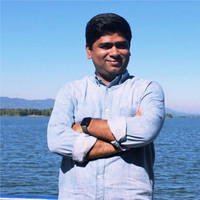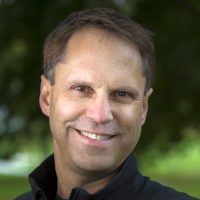Speakers

Kim Hellström
Kim Hellstöm is the Strategy Lead at H&M.

Shariful Hoque
Shariful Hoque works Water Sustainability at H&M.

J. Carl Ganter
J. Carl Ganter is co-founder and director of Circle of Blue, the center for frontline reporting, research, and analysis on water resource issues and their relationship to food and energy in a changing climate.
Kim Hellström and Shariful Hoque of H&M discuss collective actions in terms of a water agenda all over the supply chain.
Transcript
Correction: H&M has set a goal for 15 percent of total water usage to be recycled in factories by 2022, not 2020.
J. Carl Ganter: So we’re here on the floor of World Water Week, the Stockholm International Water Institute’s annual global conference here in Stockholm. And I’m here with two executives from H&M. Tell me your name and why you’re here at a water conference. H&M is a clothing company.
Kim Hellström: So I’m Kim Hellström. I work with our global sustainability department in the environmental team and of course why we’re here is basically that water is a huge key resource for us. We are using water in everything from cotton production on the fields, in the factories that we’re sourcing our fabrics and garments from, and all the way also to the customers, of course, to the consumers are using or cleaning the garments that they buy from us.
J. Carl Ganter: So it’s actually pretty obvious, really, really close, why a clothing company, a fashion company, would be here. And tell me your name and what role do you play in H&M?
The main reason why we are here is to call for collective actions because in the markets where we are operating in, the challenges have been different.
Shariful Hoque: Hi. My name is Shariful Hoque. I work as a water sustainability responsible based out of H&M Global Production, which means that wherever we have our sourcing markets, the water is a key issues, be it for the cotton cultivations and even for productions. And the main reason why we are here is to call for collective actions because in the markets where we are operating in, the challenges have been different. Being water is a local issues and it has to solve in a local context, so we are combining with all other like-minded brands so that we can have a collective actions in terms of a water agenda all over the supply chain.
J. Carl Ganter: Wow, so I moderated the session on collective action with the World Bank, the World Economic Forum on Sunday. And one of the key points was there’s in a sense, believe it or not, there’s a fear level in collective action, working together or not. And then we were talking about some of the big impediments, and there’s a trust level.
So what role is… I mean, you’re probably right in the middle of that. How do you build collective action in a space that is competitive, that’s complicated, that has long supply chains? How do you do that?
How do you build collective action in a space that is competitive, that’s complicated, that has long supply chains?
Kim Hellström: One of the things that we believe very much in is transparency. For example, we have for a couple of years shown all of our suppliers online. For us, that’s a way also to be able to map which factories are we using. Other companies can look at that. Are we using the same factories and thereby seeing where we can interact with each other?
So, I’m hoping also for more companies to take that step so that we easier can see where we can interact. Because one of the challenges that we have is we gather in different forums, we talk about cooperation, we find our match, and then it turns out we don’t share the same factories. And it becomes one step back again. So transparency is key for us. It’s a sign of leadership.
J. Carl Ganter: Well, so the leadership part, I mean, so you’re out front. Do you have many followers? Or what kind of work is left to do in not only just the industry but the supply chain?
Shariful Hoque: I think we have many like-minded brands, I would say. It’s not followers. I mean we are part of the program and we want to collectively address all those challenges. And we also have found that the many supply chain partners that we are using, we are presenting to the same business partners. So our challenges are the same. We are located in the same water basins. And the challenges, how to address those challenges, the solution should be the same for everyone. So I think that’s not in fear. But then I would say that we may compete in business, but when it’s comes to the source of solutions like water, we will continue to work as together.
J. Carl Ganter: I mean, Bangladesh has some really profound water challenges and some real potentially crisis moments. What role do you see in shifting that at speed? This isn’t a 10-year conversation. This is like, as somebody said… I said, “Well, it has to happen now, right?” And they said, “No, no, it has to happen now, now.” They corrected me. So how do you accelerate?
Shariful Hoque: Being Bangladesh is one of our important production countries, we have looked into what are the possibilities to work on the water sectors? And few years back we have actually been supported one of the study, what are the water regulatory gaps in Bangladesh and how to overcome all those things together with WWF? We also had done a study on the impact of water. What would be the business impact if the water is not available in the near future?
So looking into those solutions we have started to discussion with the multi-stakeholder partnership in Bangladesh that how those solutions can be taken place, make a position in the policymaking process and also taking those to government.
So that we started those discussion to take place slowly but then surely, and I think we have gained a lot of… We’re already aware we are been working together with Bangladesh government to start the study on the shadow price of water, which is also important aspects of valuing water. And we also learned that in many of the countries where we are operating in like Bangladesh, a lack of having a price tag is a kind of a root cause of the problem.
J. Carl Ganter: So it gets us over to the value of water, which is one of the topics here on this, what we call the transformation map here, which intersects many of the many issues of global risks, economics, institutional investors, fourth industrial revolution, future of economic progress. So what role does an H&M play, say, in pulling that level of transparency and accountability back at the national or regional government level? I mean, do you see that as impediments? Or are they becoming partners? That seems like a lot of embedded either practices or embedded interests could stand in the way. Are you seeing some of that being overcome, either in Bangladesh or elsewhere?
Shariful Hoque: I think we, as a company, we also learning how to work on those things, barriers, and how to remove all those barriers. Most importantly, it’s about we start a dialogue. We started a dialogue and we shared our challenges and we bought our, all the stakeholders in the delivery business. We are talking to certain terms and all the how to find the solutions for not only for us, for the whole sector or for the whole business. So in a way I think we are been in a process of removing those impediments rather than talking about our kind of getting blocked on those impediments at all.
J. Carl Ganter: So give me a sense in the corporate boardroom. So when you’re presenting water risks or water opportunities or engagement, you mentioned the supply chain and the customers. What most captures your CEO’s attention or say, the attention of shareholders in a public company?
Kim Hellström: That’s quite easy. That’s the future customer. How do we prepare and how do we be one step ahead of what the customer of tomorrow will demand from us? We need to stay relevant in the future because there is an awareness rise ongoing. It’s differently quick in different markets in different countries, but it is coming, of course, and we need to be one step ahead of the customer so that they continue to go to us and see that we are becoming a truly sustainable company.
J. Carl Ganter: Also, the customers are, I mean H&M and a lot of the other, you know, kind of brands in that mid or really, you know, affordable fashion. Put it that way. Again, back to a leadership role, you believe that the customers aren’t just buying on price?
Kim Hellström: I think that the awareness is rising. Right now there’s a lot of… Still, it’s fashions. It’s still, you can’t just put out sustainable clothing that looks terrible. Nobody will buy it. So, it needs to make sense from that perspective too. And my point was that I think that as the corporate and as the government regulatories needs to be one step ahead of the consumer, we can’t put the blame or the responsibility in the consumer making the right choice.
So we have to be one step ahead, both for staying relevant but also for doing the right thing and making it happen.
J. Carl Ganter: Wow, that’s really fascinating. So one more question for both of you. So if we’re sitting here next year, what’s the biggest challenge that we overcame over the next year? What’s the big story as we’re sitting here next year? You know, either good or bad. I mean, what’s the big story?
Kim Hellström: So hopefully we have a goal for 2020 to have the 15 percent of our factories, or sorry, 15 percent of the total water usage to be recycled within the factories. I really hope that we will achieve that and I will be super proud if we do that by next year, yeah.
J. Carl Ganter: Back to Bangladesh then.
Shariful Hoque: Oh, I mean not only for Bangladesh, I think for all the production country where we are working, we are looking ahead with water efficiency which means that as a brand, as a group we want to reduce our water consumption on each pieces of product, apparel or garments that we are producing. We want to reduce that water consumptions and we hope that next year we will be able to celebrate our success.
J. Carl Ganter: Great. I just wanted to ask one more question though too is, when we were talking about some of these grand challenges, you know, we spent a fair amount of time and in some pretty harsh scenarios actually for Bangladesh, for India, for that region. What role is say, H&M or is the private sector playing in starting to drive these really uncomfortable conversations of transboundary waters and general, you know, macro water management?
Shariful Hoque: How we look at or how we address those scenarios is we look at, we talk on a business level and then what are the countries that are into all this business? We are been part of that business as a water user and also in kind of a responsible brand that we are sourcing from that country or that business exactly. So, in that way I think we recognize that is a problem and we accept that it need a dialogue being with all the stakeholders, starting from government policy makers and users, our business partners, everybody need a kind of a dialogue to how to overcome all those things. And we learned over the last few years that it’s a local issues and the solution lies over there. So it’s not a kind of affair we can solve it from outside. It has to, the solution came from within.
J. Carl Ganter: Right. So solutions from within. And on the global perspective, you’re probably playing this.
Kim Hellström: Yeah. I mean, I think that also the size of the company, the bigger size, the bigger responsibility you have because your platform is bigger, you have more resources, you have the bandwidth to achieve things, basically. So I think the bigger organizations needs to spur each other into some kind of, almost compete about this because that’s what we normally do. And then the smaller companies should be able to piggyback on us. We can’t put the same pressure on smaller companies as we should on the bigger companies.
J. Carl Ganter: Part of that supply chain and systems, you know, systemic approach, I suppose. Well, if all that happens, we’ll be back here next year, World Water Week in Stockholm. I’m J. Carl Ganter for Circle of Blue.
Related
© 2025 Circle of Blue – all rights reserved
Terms of Service | Privacy Policy




